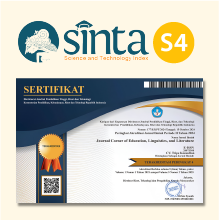The Role of Islamic Religious Education Teachers in Teaching Prayer Times: A Fiqh and Astronomical Perspective
 https://doi.org/10.54012/jcell.v4i001.475
https://doi.org/10.54012/jcell.v4i001.475
 Abstract views: 65
Abstract views: 65
 PDF downloads: 72
PDF downloads: 72
Keywords:
Islamic Religious Education, Prayer Times, Fiqh, AstronomyAbstract
This research aimed to analyze the role of Islamic Religious Education in exploring how fiqh and falak contribute to determining the precise timing of prayers. Prayer is one of the fundamental pillars of Islam and must be performed according to its prescribed times. In the Qur'an and Hadith, the times for prayer are mentioned based on the movement of sunlight as seen from the earth (Ru’yah Methode). However, due to changes in natural phenomena, sunlight is not always visible from the earth because of clouds or other factors. Therefore, it needs to be compared with the science of astronomy or astronomy, which has proven to be accurate and valid (Hisab Methode). Thus, in this case, there is a mutualistic symbiosis, where what is done by the ru’yah methode can be used as empirical evidence of the results of the hisab Methode, and vice versa. Islamic Religious Education teachers play an important role in guiding students to understand prayer times from the perspective of fiqh and astronomy.
Downloads
References
Al-Qalyubi, S., & Umairah, S. (n.d.). Qalyubi wa Umairah. Dar Ihya al-Kutub al-Arabiyyah.
Al-Qur’an, L. P. M. (2023). Al-Qur’anul Karim. Kementerian Agama Republik Indonesia. https://quran.kemenag.go.id
Al Zuhaili, W. (2006). Ushul al fiqh al islamiy. Dar Al Fikr.
Ardi, U. S. (2020). Problematika Awal Waktu Shubuh Antara Fiqih Dan Astronomi. AL-AFAQ: Jurnal Ilmu Falak Dan Astronomi, 2(2).
Bashori, M. H. (2015). Pengantar Ilmu Falak: Pedoman Lengkap Tentang Teori dan Praktik Hisab, Arah Kiblat, Waktu Salat, Awal Bulan Qamariah & Gerhana (A. Zirzis (ed.)). Pustaka Al Kautsar.
Butar-Butar, A. J. R. (2017). Kajian Ilmu Falak Di Indonesia: Kontribusi Syaikh Hasan Maksum Dalam Bidang Ilmu Falak. Journal Of Contemporary Islam And Muslim Societies, 1(1), 113–134.
Faiz, A. B. D. K. (2021). Waktu Shalat (Kajian Fiqih Dan Astronomi). IPN Press.
Ismail, I. I., & Husnaini, H. (2021). Aktualisasi Jadwal Salat Sepanjang Masa Abu Muhammad Isa Mulieng Aceh. Islamic Review: Jurnal Riset Dan Kajian Keislaman, 10(1), 93–110.
Khazin, M. (2004). Ilmu falak dalam teori dan praktik: perhitungan arah kiblat, waktu shalat, awal bulan dan gerhana. Buana pustaka.
Muslim. (2025). Hadits.id. Hadits Shahih Muslim No. 966 - Kitab Masjid Dan Tempat-Tempat Shalat. https://www.hadits.id/hadits/muslim/966
Novegar, I., Rahmatiah, H. L., & Wijaya, A. (2023). Analisis Ilmu Falak Tentang Pelarangan Waktu Salat. HISABUNA: Jurnal Ilmu Falak, 4(2), 138–157.
Pujianti, E., & Nugraha, H. A. (2024). The Role of Islamic Religious Education Teachers in Shaping the Inclusive Character of Students. Journal Corner of Education, Linguistics, and Literature, 4(001 SE-Articles), 371–380. https://doi.org/10.54012/jcell.v4i001.402
Qorib, M., & Rakhmadi, A. J. (2023). Tolerance and Moderation in the Formulation of A Global Islamic Calendar. Al-Fikru: Jurnal Ilmiah, 17(2), 343–357.
Raharto, M. (2001). Posisi Matahari untuk Penentuan Awal Waktu Salat dan Bayangan Arah Kiblat. Workshop Nasional Mengkaji Ulang Penentuan Awal Waktu Salat & Arah Kiblat, 8.
Suyati, S., Ali, I., Radinal, W., & Arrohmatan, A. (2023). METODE PENDIDIKAN PERSPEKTIF TAFSIR TARBAWI. Jurnal Insan Cendekia, 4(1). https://doi.org/10.54012/jurnalinsancendekia.v4i1.133
Yani, M. (2021). Hakikat Guru dalam Pendidikan Islam. Sulawesi Tenggara Educational Journal, 1(2), 34–38.
Zainal, A. A. Z., Latuconsina, M., & Akmal, M. (2022). Analisis Relevansi Syafaq Ahmar Terhadap Penentuan Akhir Waktu Shalat Magrib Perspektif Ilmu Falak. HISABUNA: Jurnal Ilmu Falak, 3(3), 1–18.
Downloads
Published
How to Cite
Issue
Section
License
Copyright (c) 2024 Arrohmatan Arrohmatan, Sri Mutiara

This work is licensed under a Creative Commons Attribution-ShareAlike 4.0 International License.
All articles published in the Journal Corner of Education, Linguistics, and Literature are licensed under the Creative Commons Attribution-ShareAlike License (CC BY-SA).

















